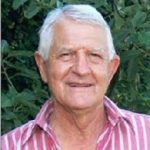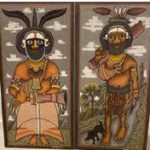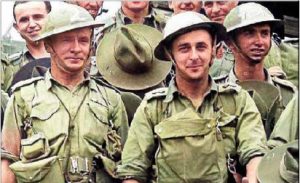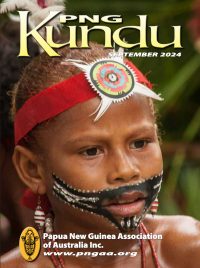LETTERS & REVIEWS
South Pacific Aero Club Memorabilia
Having been the foundation secretary and Strip Report editor of the South Pacific Aero Clubs (SPAC) in the mid-1960s, I am in the process of writing a family history and my involvement in PNG aviation between 1963 and 1967.
For nostalgic reasons, when my wife and I had gon pinis, I took my copies of all the club’s minutes, newsletters, and other historically significant documents. About 30 years ago I decided to offer the PNG government all the copies of the cinema newsreel and TV news stories I shot in PNG during that period, including coverage of the UN Teams doing their inspections leading up to independence.
Fellow aero club member, Ray Thurecht, had arranged to meet Wilma and me in ’Moresby to assist in finding, without success, a government organisation that might have been interested. I also handed over to Ray all my SPAC archive material for donation and safekeeping, and if not already preserved, hopefully at the club or other local archives, although at the time, the club had appeared to have almost collapsed.
I hope some PNGAA members may be able to provide me with contact details of the club if it still exists, or where those early records may still be found. Some of the information therein would assist in verifying my declining memory.
My phone number in Perth is 08 6277 3751, and my email address is darylbinning@outlook.com
Daryl Binning OAM, ACS
Our Strong Bond
I found the address by Papua New Guinea’s Prime Minister, James Marape, to the Australian Parliament last February, both inspiring and moving. It will re-assure many Australians and indeed other members of the ‘Pacific Family’ of the strong historic, social and strategic bond between our two countries; a bond that will not be breached by the cheque book tactics of other countries.
Having served as a kiap in the Huli region of the then Southern Highlands District in the early 1950s, it was with some nostalgia that I noted Mr Marape’s place of origin is the Huli region.
It was at Rumurumu, now known as Tari, with two other kiaps that we built the airstrip and station in 1952. The story of the landing of the first aircraft on 18 August of that year is told on the internet titled, ‘First Plane at Tari’. This story was first published in Una Voce (PNG Kundu’s forerunner) in 2015. It is very likely that James Marape’s grandfather or even his father, was present on that historic occasion, amongst the thousands of Huli people who flooded the uncompleted airstrip.
On 24 February, I asked the Papua New Guinea High Commissioner, Mr John Kali, to pass the appreciation and gratitude of myself and my wife to Mr Marape. Just a small piece of Papua New Guinea’s extraordinary history.
Quentin Anthony
John Groenewald’s Diary Now Available on PNGAA Website
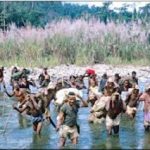 Ross Johnson recently completed a mammoth and important job digitising and compiling six parts of John Groenewald’s Diary—1963 Star Mountains Patrol, including the prologue and slides—into a series of PDF files that are now available on the PNGAA website.
Ross Johnson recently completed a mammoth and important job digitising and compiling six parts of John Groenewald’s Diary—1963 Star Mountains Patrol, including the prologue and slides—into a series of PDF files that are now available on the PNGAA website.
John, a patrol surveyor, was part of a five-month patrol that entailed trekking 500 miles through mountainous terrain, fast-flowing rivers and swampy plains. Led by District Officer (DO) Des Fitzer, with ADO Ross Henderson, John Groenewald, a small group of police and approximately 60 carriers (above), the patrol left Kiunga on 17 January 1963. You can read some of the background to this patrol in Judith Blogg’s article in Una Voce, December 2016.
Roy Ranney has uploaded the complete diary on the PNGAA website. Members can read them via the members-only link HERE.
John Groenewald passed away in Western Australia on 12 February 2016. Des Fitzer passed away on 27 June 2006 in South Australia.
PNGAA extends its gratitude to Ross and Roy for making this fascinating chapter of PNG history accessible.
Track vs Trail
I noticed the debate re ‘Track vs Trail’ was raised again in the last issue. I have published the following two articles on the issue: ‘The Kokoda Trail: 10 Essential Facts’ and ‘Official Name of the Kokoda Trail’.
I have the highest regard for Dr Karl James’ historical research regarding the Kokoda Campaign, however, he is trying to have a ‘bob’ each way on the name and has drawn a long bow in describing ‘track’ as being ‘strongly associated with the language of the Australian bush’. If this is the case how come our vast continent is criss-crossed with ‘fire trails’? He would also be aware that Australia developed a ‘Remembrance Trail’ between France and Belgium for the Centenary of Anzac
I have been trekking across the Trail for 32 years and every sign (apart from the Isurava Memorial) has referred to ‘Kokoda Trail’ since I first trekked it in 1991.
It is also the official name gazetted by the traditional owners of the land, i.e. Papua New Guinea—and the name of the Battle Honour awarded to their Papua Infantry Battalion and the 10 Australian battalions who fought in the campaign.
I’m not sure what part of these facts the proponents of ‘Kokoda Track’ don’t get!
I have recently posted the following two blogs for your info:
- Papua New Guinea—A Place of Pilgrimage
- PNG Angels demonstrate the philanthropic potential of Kokoda Tourism
Best regards, Charlie
Charlie Lynn OAM, OL
(M): 0439 303 303
(E) charlie@kokodatreks.com.au
www.kokodatreks.com
www.networkkokoda.org
BOOK REVIEW
LORETTA GOLDBERG—Beyond the Bukubuk Tree
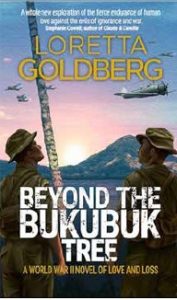 This historical novel by an award-winning author was published in late June. The 378-page paperback and e-book is set against the backdrop of WWII in East New Britain. The story is promoted as a World War II novel of love and loss.
This historical novel by an award-winning author was published in late June. The 378-page paperback and e-book is set against the backdrop of WWII in East New Britain. The story is promoted as a World War II novel of love and loss.
Published by Made Global Publishing (2024)
ISBN 978-84-122325-8-5
ASIN: B0D4MH8D63
The paperback version is available through any good bookstore and Amazon, as is the e-book. You can read more about the book at https://mybook.to/bukubuk
What is a Kiap?
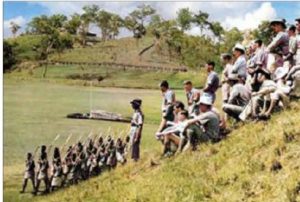
A group of cadet patrol officers (kiaps) are shown the Royal Papuan
Constabulary police barracks at Sogeri, 1950
Bill Sanders’ article in the last PNG Kundu issue about the proposed Kiap Memorial in Canberra got my aged brain thinking that many, especially some of the younger readers, may be wondering who or what a KIAP was.
The word kiap, so I am informed, comes from the Tolai people of Rabaul and their interpretation of the German word for ‘captain’—which quickly became the nickname in all of Papua New Guinea for a patrol officer.
A Cadet Patrol Officer (CPO) was naturally of the lowest kiap rank and hopefully, if one passed muster, one advanced up a couple of grades of Patrol Officer then Assistant District Officer, then District Officer with Patrol Officers under him being responsible for a vaguely defined patrol post area and the ADO and the DO assuming the running of larger settlements, including small towns.
At the very top was the District Commissioner, generally known as God’s Right-Hand man, who was the co-ordinator of all government departments in a particular district.
And yes, compared to today, the then Department of Native Affairs to which all kiaps belonged, included sexist and racist individuals, and that’s how it was then. No such person as a female kiap was recruited, and PNG males were not recruited on a mass scale until the 1970s.
Kiaps had a sort of basic law to administer ‘Native Administration Regulations’, which only affected indigenous people and had rules on what local people could wear and the times they were allowed in towns and other settlements!
A kiap could be gazetted as a commissioned officer of the Royal Papua and New Guinea Constabulary plus also as a reserve magistrate of a district court. All races were subject to the jurisdiction of both courts (hearing statutory places cases where district cases could be heard involving all people), but his main job was patrolling—sometimes into what was called ‘uncontrolled’ areas; and yes, until the mid-1960s there were still parts of the Highlands and the Sepik where a European had not visited!
Patrolling involved trudging up and down jungle slopes to visit various villages, taking perhaps a couple of weeks to visit everyone. The kiap was welcomed by a luluai (village headman) or a tul-tul (2IC) and all the assembled villagers because the kiap’s visit was something of an event and out of the ordinary. In island or river areas, your feet could take it easy as patrolling was undertaken by a workboat or motor canoe.
At the conclusion of a patrol, a patrol report was sent up the chain of command with notes on how the patrolled area was going, recommendations for economic development and anything else that might be of interest. A link for where old patrol reports can be accessed is Papua New Guinea Patrol Reports | Collection | Library Digital Collections | UC San Diego Library (ucsd.edu)—The digital library collection of Melanesian Anthropology at the San Diego Library in the USA.
Patrolling was arduous sometimes but usually never dangerous, at least in my case, except for tripping over a log, standing on a snake or keeping a wary lookout for crocodiles when wading through rivers.
A notable exception was the murder of PO Gerald Szarka, CPO Geoffrey Harris, Constables Purari and Buritori at Telefomin in the mountains of the Sepik District in November 1953.
The kiap’s role abruptly changed in the mid to late ’60s when the Australian Government suddenly woke up to the fact that Independence might be the way of the future in the Territories. Kiaps then had the job of informing people about House of Assembly elections and forming Local Government Councils.
A kiap was a bit of a ‘Jack-of-all-trades’ and, in my time in PNG, I had a chat with a cannibal, disinterred a Swiss citizen, witnessed in the trial of a murdered witch, defended arrested Taiwanese fishermen, supervised the construction of an airstrip, investigated a cargo cult and helped host a cocktail party two to three metres underwater, to name just a few out of the ordinary jobs. Other kiaps should be able to list some of the odd jobs that came their way.
Kiaps started winding down from the early 1970s when we were virtually kicked out of our job by the then Australian Government, though still warmly remembered by the ordinary people of PNG, as exemplified by the time my wife and I went on a cruise. I was subjected to handshakes and pats on the back as a lapun kiap (ancient Patrol Officer). It seems that we have gone into folklore and tradition.
John B Quinn
Editor’s Postscript: More can be read about the 1953 Telefomin murders in an article penned by Bill Brown MBE at https://www.pngattitude.com/2013/04/the-telefomin-murders-revisited-the-gritty-detail.html
PNG Portraits
I am the retired Chairman of USA Rugby League, living in Newcastle, NSW. I wish to contact someone from the PNG community in Newcastle or Sydney and hand these portraits to them. The PNG Prime Minister gave me two portraits in Port Moresby during the Rugby League World Cup in 2017. I would like to hand them to a Papua New Guinean.
Can you help me contact the appropriate PNG community in Newcastle or Sydney, please?
Peter J Illfield
(E) pillfield@icloud.com
BOOK REVIEW
DAVID HOWELL—Kokoda Legend: Captain Sam Templeton
 Templeton’s Crossing was named by Bert Kienzle in honour of a brave soldier, Captain Samuel Victor (Sam) Templeton.
Templeton’s Crossing was named by Bert Kienzle in honour of a brave soldier, Captain Samuel Victor (Sam) Templeton.
Templeton’s name and actions are synonymous with Kokoda. Sam was the Officer Commanding (OC), B Company, 39 Battalion (Bn) which spearheaded the battalion in its march to Kokoda to stop the Japanese advance over the Kokoda Trail. He disappeared and was assumed killed near the village of Oivi fighting the Japanese. His body was never found.
The book describes how Sam was captured by the Japanese, interrogated, tortured and executed on 26 July 1942. He was the first officer to be captured in the Kokoda Campaign. Sam gave misleading information about allied military strengths at Kokoda, on the Trail and in Port Moresby, which significantly assisted the Allied campaign.
Born in Belfast, Northern Ireland, to Protestant parents on 28 January 1901, Sam migrated to Australia in June 1921, settling in Victoria, and marrying in 1928. After enlisting in the Militia in September 1930, he received regular promotions, and was called up on 5 October 1939.
On 7 October 1941, aged 40, he was posted to 39 Infantry Battalion as OC B Company as a lieutenant. The 39 Bn departed Sydney on 28 December 1941, arriving at Port Moresby on 3 January 1942. On 15 April Sam was promoted to Captain.
B Company 39 Bn—com-prising Sam, four other officers and 125 men—began their trek to Kokoda on 7 July, arriving there on 15 July.
The Japanese invaded Buna on 21 July and B Company was ordered to make a stand near Gorari Village, but moved back to just west of Oivi Village, about 16 km east of Kokoda in the Kumusi and Mambare Rivers’ watershed. It was here where Sam disappeared.
Sam’s story is told in detail in David Howell’s book, and this well-researched, referenced, 268-page book is soft-back and printed in clear, large print. It is chronologically written and easy to read. There are appropriate photographs and maps as well as abbreviations, bibliography and endnotes.
I enjoyed reading the story. The book removes the myths and discusses the real contribution made by Captain Sam Templeton in the Kokoda Campaign.
Published by Big Sky Publishing Pty Ltd, 2024
ISBN: 978-1-923004-980-6
RRP $30.00
Phil Ainsworth
President of the NGVR & PNGVR
Ex-Members Association
Phil was a company commander in PNGVR in the 1960s. In 1963, he walked the southern route through Deniki to Kokoda during ‘Exercise Long Hop’, a replay of 1942 being a combined exercise involving PIR and SAS.

